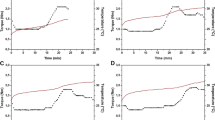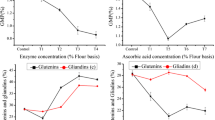Abstract
The improvement of the processing properties of gluten-free cereals is a challenging issue for cereal technologists. Vital wheat gluten (VWG), transglutaminase (TGase), or combinations of the two have been successfully used to improve the processing properties of food materials. In this study, a Mixolab system and a rheometer were used to investigate the effects of TGase on the thermomechanical and dynamic rheological properties of buckwheat flour dough (BF dough) and a buckwheat flour dough containing 15% VWG (BF-VWG dough). The results indicated that the addition of 1.0% TGase decreased the water absorption and significantly increased the stability, storage modulus (G′), and complex modulus (|G*|) of the BF dough. The presence of 15% VWG had a synergistic effect, enhancing the effectiveness of the TGase in improving the thermomechanical and dynamic rheological properties of the BF-VWG dough. Quantification of the free amino groups showed that the amino groups were more effectively bonded in the BF-VWG dough than in the BF dough when the TGase level exceeded 1.0%. Confocal laser scanning microscopy (CLSM) and sodium dodecyl sulfate-polyacrylamide gel electrophoresis analysis confirmed that the TGase promoted the formation of protein complexes. These data indicate that the combination of VWG and TGase can be used to improve the properties of buckwheat flour for buckwheat-based food production.





Similar content being viewed by others
References
AACC. (2000). Approved methods of the American Association of Cereal Chemists (10th ed.). St. Paul, MN: The Association.
Ahn, H., Kim, J., & Ng, P. (2005). Functional and thermal properties of wheat, barley, and soy flours and their blends treated with a microbial transglutaminase. Journal of Food Science, 70, c380–c386.
Autio, K., Kruus, K., Knaapila, A., Gerber, N., Flander, L., & Buchert, J. (2005). Kinetics of transglutaminase-induced cross-linking of wheat proteins in dough. Journal of Agricultural and Food Chemistry, 53, 1039–1045.
Babiker, E. E. (2000). Effect of transglutaminase treatment on the functional properties of native and chymotrypsin-digested soy protein. Food Chemistry, 70, 139–145.
Barcew-Wiszniewska, B., Samochowiec, L., & Rózewicka, L. (1995). Extractum Fagopyri reduces atherosclerosis in high-fat diet fed rabbits. Die Pharmazie, 50, 560.
Basman, A., Köksel, H., & Ng, P. (2002a). Effects of transglutaminase on SDS-PAGE patterns of wheat, soy, and barley proteins and their blends. Journal of Food Science, 67, 2654–2658.
Basman, A., Köksel, H., & Ng, P. K. (2002b). Effects of increasing levels of transglutaminase on the rheological properties and bread quality characteristics of two wheat flours. European Food Research and Technology, 215, 419–424.
Block, R. J., & Bolling, D. (1947). The amino acid composition of proteins and foods. CC Thomas, Springfield, IL.
Bonet, A., Blaszczak, W., & Rosell, C. M. (2006). Formation of homopolymers and heteropolymers between wheat flour and several protein sources by transglutaminase-catalyzed cross-linking. Cereal Chemistry, 83, 655–662.
Brites, C., Trigo, M. J., Santos, C., Collar, C., & Rosell, C. M. (2010). Maize-based gluten-free bread: influence of processing parameters on sensory and instrumental quality. Food and Bioprocess Technology, 3, 707–715.
Choi, S. M., Mine, Y., & Ma, C. Y. (2006). Characterization of heat-induced aggregates of globulin from common buckwheat (Fagopyrum esculentum Moench). International Journal of Biological Macromolecules, 39, 201–209.
Codina, G. G., Bordei, D., & Paslaru, V. (2008). The effects of different doses of gluten on rheological behaviour of dough and bread quality. Romanian Biotechnology Letters, 13, 37–42.
Debet, M. R., & Gidley, M. J. (2006). Three classes of starch granule swelling: influence of surface proteins and lipids. Carbohydrate Polymers, 64, 452–465.
Dinnella, C., Gargaro, M. T., Rossano, R., & Monteleone, E. (2002). Spectrophotometric assay using o-phtaldialdehyde for the determination of transglutaminase activity on casein. Food Chemistry, 78, 363–368.
Folk, J., & Finlayson, J. (1977). The-(−glutamyl) lysine crosslink and the catalytic role of transglutaminases. Advances in Protein Chemistry, 31, 1–133.
Gerrard, J. A. (2002). Protein-protein crosslinking in food: methods, consequences, applications. Trends in Food Science & Technology, 13, 391–399.
Gerrard, J., Fayle, S., Brown, P., Sutton, K., Simmons, L., & Rasiah, I. (2001). Effects of microbial transglutaminase on the wheat proteins of bread and croissant dough. Journal of Food Science, 66, 782–786.
Gujral, H. S., & Rosell, C. M. (2004). Functionality of rice flour modified with a microbial transglutaminase. Journal of Cereal Science, 39, 225–230.
Huang, W., Li, L., Wang, F., Wan, J., Tilley, M., Ren, C., & Wu, S. (2010). Effects of transglutaminase on the rheological and Mixolab thermomechanical characteristics of oat dough. Food Chemistry, 121, 934–939.
Kim, Y. S., Huang, W., Du, G., Pan, Z., & Chung, O. (2008). Effects of trehalose, transglutaminase, and gum on rheological, fermentation, and baking properties of frozen dough. Food Research International, 41, 903–908.
Köksel, H., Sivri, D., Ng, P., & Steffe, J. (2001). Effects of transglutaminase enzyme on fundamental rheological properties of sound and bug-damaged wheat flour doughs. Cereal chemistry, 78, 26–30.
Kreft, I., Fabjan, N., & Yasumoto, K. (2006). Rutin content in buckwheat (Fagopyrum esculentum Moench) food materials and products. Food Chemistry, 98, 508–512.
Krkoskova, B., & Mrazova, Z. (2005). Prophylactic components of buckwheat. Food Research International, 38, 561–568.
Larré, C., Denery-Papini, S., Popineau, Y., Deshayes, G., Desserme, C., & Lefebvre, J. (2000). Biochemical analysis and rheological properties of gluten modified by transglutaminase. Cereal chemistry, 77, 121–127.
Lodi, A., Tiziani, S., & Vodovotz, Y. (2007). Molecular changes in soy and wheat breads during storage as probed by nuclear magnetic resonance (NMR). Journal of Agricultural and Food Chemistry, 55, 5850–5857.
Marcoa, C., & Rosell, C. M. (2008). Effect of different protein isolates and transglutaminase on rice flour properties. Journal of Food Engineering, 84, 132–139.
Mattila, P., Pihlava, J., & Hellstr, m. J. (2005). Contents of phenolic acids, alkyl-and alkenylresorcinols, and avenanthramides in commercial grain products. Journal of Agricultural and Food Chemistry, 53, 8290–8295.
Milisavljevic, M. D., Timotijevic, G. S., Radovic, S. R., Brkljacic, J. M., Konstantinovic, M. M., & Maksimovic, V. R. (2004). Vicilin-like storage globulin from buckwheat (Fagopyrum esculentum Moench) seeds. Journal of Agricultural and Food Chemistry, 52, 5258–5262.
Moore, M. M., Heinbockel, M., Dockery, P., Ulmer, H., & Arendt, E. K. (2006). Network formation in gluten-free bread with application of transglutaminase. Cereal chemistry, 83, 28–36.
Morishita, T., Yamaguchi, H., & Degi, K. (2007). The contribution of polyphenols to antioxidative activity in common buckwheat and tartary buckwheat grain. Plant production science, 10, 99–104.
Nelles, E., Dewar, J., Bason, M., & Taylor, J. (2000). Maize starch biphasic pasting curves. Journal of Cereal Science, 31, 287–294.
Ozturk, S., Kahraman, K., Tiftik, B., & Koksel, H. (2008). Predicting the cookie quality of flours by using Mixolab(R). European Food Research and Technology, 227, 1549–1554.
Payne, P. I., Nightingale, M. A., Krattiger, A. F., & Holt, L. M. (1987). The relationship between HMW glutenin subunit composition and the bread-making quality of British-grown wheat varieties. Journal of the Science of Food and Agriculture, 40, 51–65.
Pinterits, A., & Arntfield, S. D. (2008). Improvement of canola protein gelation properties through enzymatic modification with transglutaminase. LWT- Food Science and Technology, 41, 128–138.
Radovic, S. R., Maksimovic, V. R., & Varkonji Gasic, E. I. (1996). Characterization of buckwheat seed storage proteins. Journal of Agricultural and Food Chemistry, 44, 972–974.
Radovic, R., Maksimovic, R., Brkljacic, M., Gasic, I. E., & Savic, P. (1999). 2S albumin from buckwheat (Fagopyrum esculentum Moench) seeds. Journal of Agricultural and Food Chemistry, 47, 1467–1470.
Renzetti, S., Behr, J., Vogel, R., & Arendt, E. (2008a). Transglutaminase polymerisation of buckwheat (Fagopyrum esculentum Moench) proteins. Journal of Cereal Science, 48, 747–754.
Renzetti, S., Dal Bello, F., & Arendt, E. K. (2008b). Microstructure, fundamental rheology and baking characteristics of batters and breads from different gluten-free flours treated with a microbial transglutaminase. Journal of Cereal Science, 48, 33–45.
Salmenkallio-Marttila, M., Roininen, K., Autio, K., & Lahteenmaki, L. (2004). Effects of gluten and transglutaminase on microstructure, sensory characteristics and instrumental texture of oat bread. Agricultural and food science, 13, 138–150.
Sciarini, L. S., Ribotta, P. D., León, A. E., & Pérez, G. T. (2010). Influence of gluten-free flours and their mixtures on batter properties and bread quality. Food and Bioprocess Technology, 3, 577–585.
Tanaka, K., Matsumoto, K., Akasawa, A., Nakajima, T., Nagasu, T., Iikura, Y., & Saito, H. (2000). Pepsin-resistant 16-kD buckwheat protein is associated with immediate hypersensitivity reaction in patients with buckwheat allergy. International Archives of Allergy and Immunology, 129, 49–56.
Tang, C. H., & Jiang, Y. (2007). Modulation of mechanical and surface hydrophobic properties of food protein films by transglutaminase treatment. Food Research International, 40, 504–509.
Tang, C. H., Chen, Z., Li, L., & Yang, X. Q. (2006). Effects of transglutaminase treatment on the thermal properties of soy protein isolates. Food Research International, 39, 704–711.
Torbica, A., Hadna ev, M., & Dapcevic, T. (2010). Rheological, textural and sensory properties of gluten-free bread formulations based on rice and buckwheat flour. Food Hydrocolloids, 24, 626–632.
Wang F, Huang W, Kim Y, Liu R, Tilley M (2011). Effects of transglutaminase on the rheological an 1 d noodlemaking characteristics of oat dough containing vital wheat gluten or egg albumin. Journal of Cereal Science, 1–7.
Wu, J., & Corke, H. (2005). Quality of dried white salted noodles affected by microbial transglutaminase. Journal of the Science of Food and Agriculture, 85, 2587–2594.
Yokoyama, K., Nio, N., & Kikuchi, Y. (2004). Properties and applications of microbial transglutaminase. Applied Microbiology and Biotechnology, 64, 447–454.
Acknowledgments
This work was supported financially by the Basic Research Priorities Program of Ningxia province (Grant No. NZ10224) and the Science and Technology Research Program of Ningxia Regularly Higher-Learning Institutions (Grant No. [2010]297) and partly supported by the National Natural Science Foundation of the People’s Republic of China (No. 30972286).
Author information
Authors and Affiliations
Corresponding author
Rights and permissions
About this article
Cite this article
Han, L., Cheng, Y., Qiu, S. et al. The Effects of Vital Wheat Gluten and Transglutaminase on the Thermomechanical and Dynamic Rheological Properties of Buckwheat Dough. Food Bioprocess Technol 6, 561–569 (2013). https://doi.org/10.1007/s11947-011-0738-9
Received:
Accepted:
Published:
Issue Date:
DOI: https://doi.org/10.1007/s11947-011-0738-9




